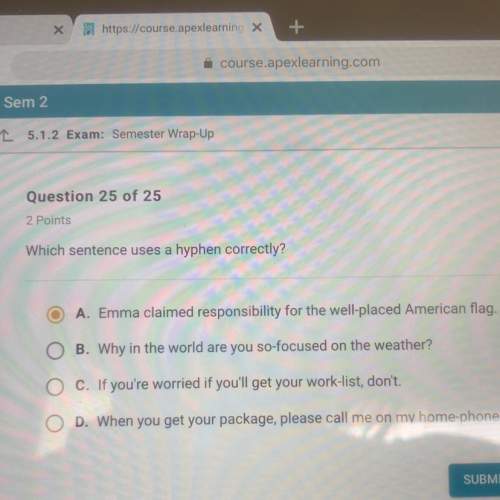
English, 14.12.2020 18:50, MayFlowers
The second part of Section II of the AP exam contains three long essay questions—you must respond to one. The AP U. S. History long essay question assesses your ability to apply knowledge of history in a complex, analytical manner. In other words, you are expected to treat history and historical questions as a historian would. This process is called historiography—the skills and strategies historians use to analyze and interpret historical evidence to reach a conclusion. Thus, when writing an effective essay, you must be able to write a strong, clearly developed thesis and supply a substantial amount of relevant evidence to support your thesis and develop a complex argument. The College Board’s characteristics of a high-scoring long essay question response are listed below. Note that the requirements are very similar to those of the DBQ; the primary difference is that any requirements related to use of the documents are removed from the scoring requirements for the long essay question.

Answers: 1
Other questions on the subject: English

English, 21.06.2019 14:00, thawkins79
What are the most ethical decisions for the newspaper to make in this situation? select two options.
Answers: 2

English, 21.06.2019 16:40, agray062103
Read this excerpt from "ain't i a woman? " by sojoumer truth in which three sentences does she make an emotional appeal to the audience by talking about her personal hardships? well, children, where there is so much racket there must be something out of kilter. {i think that 'twixt the negroes of the south and the women at the north, all talking about rights, the white men will be in a fix pretty soon.} but what's all this here talking about? {that man over there says that women need to be into carriages, and lifted over ditches, and to have the best place everywhere. nobody ever me into carriages, or over mud puddles, or gives me any best place} and ain't i a woman? look at me! look at my arm! {i have ploughed and planted, and gathered into bars, and no man could head me! } and ain't i a woman? i could work as much and eat as much as a man - when i could get it - and bear the lash as well! and ain't i a woman? {i have borne thirteen children, and seen most all sold off to slavery, and when i cried out with my mother's grief, none but jesus heard me! } and ain't i a woman? {then they talk about this thing in the head, what's this they call it? [member of audience whispers, "intellect") that's it, honey.} what's that got to do with women's rights or negroes' rights? if my cup won't hold but a pint, and yours holds a quart, wouldn't you be mean not to let me have my little half measure full?
Answers: 3

English, 22.06.2019 01:50, jurnee77
Plagiarism quiz read both the paragraph below and the information following it that identifies the source using the american psychological association format. then read each of the numbered statements and determine if each is plagiarized or not. circle “yes” if the statement is plagiarized, “no” if it is not, and then fix the “yes” answers). original source the presence of the taiwanese on everest was a matter of grave concern to most of the other expeditions on the mountain. there was a very real fear that the taiwanese would suffer a calamity that would compel other expeditions to come to their aid, risking further lives, to say nothing of jeopardizing the opportunity for other climbers to reach the summit. but the taiwanese were by no means the only group that seemed egregiously unqualified. camped beside us at base camp was a twenty-five-year-old norwegian climber named peter neby, who announced his intention to make a solo ascent of the southwest face, one of the peak’s most dangerous and technically demanding routes—despite the fact that his himalayan experience was limited to two ascents of neighboring island peak, a 20,274-foot bump that required little more than vigorous walking. krakauer, j. (1998). into thin air: a personal account of the mount everest disaster. new york: anchor books, 122 - 3. student samples yes 1. there was a very real fear that the taiwanese would suffer a calamity that would compel other expeditions to come to their aid(krakauer, 1998). no) 2. many climbers overestimate their abilities, as krakauer (1998) explains when he writes of peter neby, whose himalayan experience in the past “required little more than vigorous walking” (122 - 3). no 3. jon krakauer (1998) discusses other concerns besides those of unpredictable weather and his own climbing group’s capabilities. for example the existence of a taiwanese group on everest was a matter of serious unease to most everyone else on the mountain. yes/no 4. krakauer (1998) states that the taiwanese group was not the only inexpert climbers to attempt mt. everest: camped beside us at base camp was a twenty-five-year-old norwegian climber named peter neby. . [whose] himalayan experience was limited to two ascents of neighboring island peak, a 20,274-foot bump that required little more than vigorous walking (122 – 3). yes/no 5. the author asserts that the taiwanese “were by no means the only group that seemed egregiously unqualified.” yes/no 6. in his book into thin air, jon krakauer (1998) discusses many of the dangers he noted prior to his disastrous attempt to climb mt. everest in 1996. among them were encounters with other groups and individual climbers who were ill-trained and ill-equipped to handle the demands of such a climb.
Answers: 2
Do you know the correct answer?
The second part of Section II of the AP exam contains three long essay questions—you must respond to...
Questions in other subjects:



English, 24.06.2019 19:20




Biology, 24.06.2019 19:20









